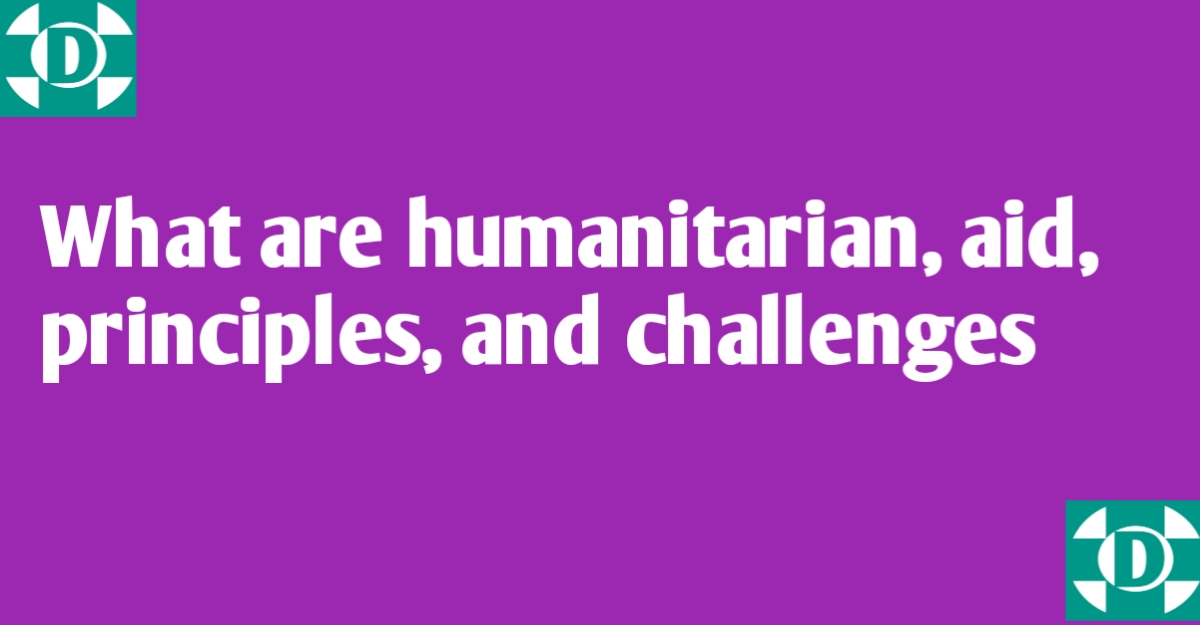What are humanitarian, aid, principles, and challenges

Understanding humanitarian aid, principles, and challenges?
Introduction to Humanitarian?
Helping people in suffering is an awesome feeling, courageous and rewarding. The world’s most famous humanitarians, like Mahatma Gandhi, Nelson Mandela, and Mother Teresa, have worked tirelessly and the results of their efforts have changed the course of our history.
We all need to live a harmonious and easier life, a life of peace and satisfaction. To achieve this among the people we live together, some have to help and alleviate others suffering. These people who give help to others are called humanitarians or philanthropists.
Humanitarian also refers to the act of helping people who are in need to promote their well-being and alleviate their suffering.
In this post, I will discuss all about “humanitarian”: its meaning, principles, aids, Organizations and services.
I will make sure you understand all about humanitarian work so that you don’t need to go somewhere else looking to know something about humanitarian work.
You have already come here, and this is the right place. To start the journey, let’s begin with a steady movement, reaching all the areas, corners, and junctions we need to know in our journey in the humanitarian field. Let’s begin.
Read also: How to become ICU nurse: Responsibilities, certificate and salary
What is a humanitarian?
Humanitarian simply means promoting human welfare. It also means a person promoting human welfare and social security.
Humanitarian as a broad term is related to the principles and practices of promoting the well-being, rights, and dignity of humans.
It consists of actions, organizations, and individuals (philanthropists) working to promote health, alleviate suffering, satisfy the needs of people who are facing challenges, including arm conflicts, disasters, epidemics, and especially those unable to get medical intervention, food, or shelter.
If you understand the above definition of humanitarian, I’m very sure that you can say something about humanitarian even in the conference room of the World Health Organization.
However, philanthropists and governmental and non-governmental organizations are helping people who are affected by disasters, epidemic and arm conflicts by preventing their harm and alleviating their suffering. This happened through humanitarian aid.
Humanitarian aid is usually a short-term aid to people in suffering to ease their situations before a recognized body or government takes over.
Read also: 5 simple Steps to become a midwife in 2024
Humanitarian principles
The principles of humanity, neutrality, impartiality and independence are fundamental to humanitarian action. Humanity means that human suffering must be addressed wherever it is found, with particular attention to the most vulnerable.
Humanitarian non-governmental organizations’ actions are guided by humanitarian principles. In this section, we are going to talk about humanitarian principles thoroughly.
-
Humanity
Humanity is the first principle of humanitarianism, which means that all humankind shall be treated equally with respect regardless of their age, gender, race, religion, economic status, or educational background.
This means giving them help in any situation where they are in need to save their lives and alleviate their suffering.
-
Impartiality
When giving humanitarian assistance to people in need, the state of equality and balance should be respected and maintained without showing any discrimination.
The principle of impartiality makes no discrimination as to nationality, race, religious beliefs, class or political opinions.
It endeavors to relieve the suffering of individuals, guided solely by their needs, and to give priority to the most urgent cases of distress.
-
Neutrality
Neutrality means that humanitarian aid must not favor any side in an armed conflict or other disputes, including those of a political, racial, religious or ideological nature.
According to the principle of neutrality, to be neutral means not taking sides in a conflict, whether directly or by allying oneself with one or another party to the conflict.
-
Independence
The principles of independence mean the autonomy of humanitarian objectives over political, economic, military or other objectives.
The humanitarian non-governmental organization should form its policies independently of government policies.
According to Wikipedia about the principle of independence, Said, “although there are auxiliaries in the humanitarian services and they are subject to the laws of their countries, they must maintain their autonomy from political, economic, military or any other others and to be able at all times to act in accordance with the humanitarian principles.”
Apart from humanitarian principles, there is another set of laws that assist humanitarian activity; the law is called international humanitarian law. What does this law say? Let’s answer the question in the heading below.
Read also: Nurse practitioner Aspirant, Best steps become one in 2024
International humanitarian law (IHL)
International humanitarian law (IHL) is a set of rules that seek to limit the effects of armed conflict. It lays out the responsibilities of states and non-state armed groups during an armed conflict.
IHL is also known as “the law of war” or “the law of armed conflict.”
Humanitarian Organizations
Humanitarian organizations are international, independent, humanitarian, and non-governmental organizations that give aid to the people who are suffering, particularly victims of armed conflict, famines, and natural disasters. Sometimes these organizations are also called relief societies.
Below is a list of humanitarian organizations
- United Nations
- Coordination of Humanitarian Affairs
- United Nations Office for the Coordination of Humanitarian Affairs
- International Committee of the Red Cross
- World Food Programme
- World Vision International
- UNICEF
- Action Against Hunger
- Oxfam
- Doctors Without Borders
- Cooperative For Assistance and Relief
- Islamic Relief Worldwide
- International Rescue Committee
- International Medical Corps
- International Federation of Red Cross and Red Crescent Societies
- American Red Cross
- United Nations System
- Refugees International
- World Jewish Relief
- Direct Relief
- United Nations High Commissioner for Refugees
- Save The Children
- Care International
- World Help
Humanitarian Crisis
Humanitarian crises can be defined as events such as natural disasters, civil wars or epidemics. Humanitarian crises are characterized by the fact that they endanger the health, well-being and safety of a large group of people.
It often represents a combination of man-made and natural hazards and is often characterized by the spread of violence, consequent loss of life, profound damage to economies and societies, displacement of populations, and difficult conditions for humanitarian assistance.
Types of Humanitarian crisis
Humanitarian crises can either be natural disasters, human-made disasters, Epidemic or complex emergencies. In such cases, complex emergencies occur as a result of several factors or events that prevent a large group of people from accessing their fundamental needs, such as food, clean water or safe shelter.
Solution to Humanitarian crisis
According to United Nations High Commissioner for Refugees (UNHCR). Virtually any wicked humanitarian problem can be solved by applying the following 7 powers:
1) vision
2) innovation
3) human-centered design
4) collaboration
5) venture philanthropy
6) passion, and
7) perseverance.
Global Humanitarian review
Global Humanitarian Overview 2023, Mid-Year Update (Snapshot as of 18 June 2023).
Reliefweb reported, as of mid-June 2023, the Global Humanitarian Overview requires $54.8 billion to assist 249 million of the 362 million people in need. The GHO is made up of 26 Humanitarian Response Plans (HRP), nine regional plans, five Flash Appeals, and other types of plans.
Requirements this year are around $8.4 billion more compared to the mid-year point in 2022, representing an increase of 18 per cent, which is smaller than the almost 30 per cent increase experienced in the first semester of 2022.
Donors have provided $10.7 billion as of mid-year for the GHO plans, which represents 20 per cent of the total required this year.
Source: Reliefweb.
To cover the term “Humanitarian” we cannot forget with “Humanitarian aid” although they are related but they slightly tells different concept.
Let’s talk about humanitarian aid to see what does it consist.
Understanding Humanitarian Aid
Humanitarian Aid refers to the specific assistance support of materials provided to the people in need during crisis or emergencies.
It includes materials such as food, essential drugs, clothes and other materials necessary for living to the people in need.
This is aimed at promoting health, alleviating suffering, providing basic necessities, and to assist affected community to recover, while protecting their dignity.
Difference between Humanitarian and Humanitarian Aid
In summary, “humanitarian” is a broader concept related to the principles of compassion, empathy, and human dignity. Humanitarian concerned with or seeking to promote human welfare. While “humanitarian aid” is the material and logistics assistance and support provided to individuals and communities in distress, guided by these humanitarian principles.
Humanitarian Aid is usually short-term helps, until replaced with long-term help from another institution. Humanitarian aid is the practical application of humanitarian principles.
Medical Humanitarian aid and Challenges
The medical humanitarian aid also known as medical aid, is a specific type of humanitarian assistance that is focused on providing medical care and support to individuals and communities in crisis, arm conflict, disaster, epidemic or other emergency situations. This type of aid is delivered by medical professionals, including doctors, nurses, and other healthcare workers, as well as humanitarian organizations.
Read also: How to become a nurse in UK 2024
Types of medical and humanitarian aid
There are different types of medical humanitarian aid, and we will look at the ones we have here:
Providing medical services and equipments
This includes providing essential drugs and medical equipment needed to address health issues, such as provision of intravenous fluids, Oral rehydration solutions, zinc sulfate in response Cholera outbreak.
On the other hand, medical equipment such as pulse oximeter, thermometer, syringes, and so on.
Sending health professional to an affect area or community
In an area or community affected with arm conflicts, natural disaster, or pandemic there need to assist people with medical support, medical professionals including doctors, nurses are needed to save life of the people affected.
Provision of Healthcare facilities
Some people are very far away from hospital as a result many have died from preventable disease, establishing hospital in an area of emergencies can improve the quality of healthcare delivery and saving life of vulnerable people.
Public health initiatives
Health education is part of medical humanitarian aid, as it’s crucial element that brings awareness on infectious and communicable diseases. Furthermore, this helps in implementing programs to prevent the spread of diseases, promote hygiene, and ensure access to clean water and sanitation.
Nutrition Centers
Not every community or group of people need medical care, some people those that are affected with malnutrition especially children need therapeutic feedings to address their health conditions.
Medical humanitarian aid challenges
Humanitarian organizations are now increasingly facing challenges where populations are under different layers of pressure:
- Demographic pressure
- Economic forms of pressure
- Pressure from natural and technological disasters
- conflict pressure
- Climate change pressure

